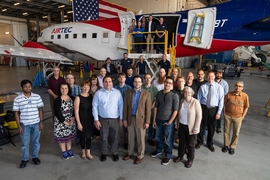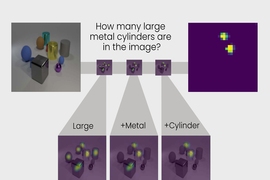Ten technologies developed at MIT Lincoln Laboratory have been honored with 2018 R&D 100 Awards. The awards have been presented by R&D Magazine annually since 1963 and recognize the 100 most significant inventions of the year.
“The R&D 100 Award is one of the top awards for recognizing new technology,” says Eric Evans, the director of Lincoln Laboratory. “Receiving 10 awards in one year is a great recognition of the quality and scale of Lincoln Laboratory work and all of the excellent technical and support staff involved.”
A panel of independent experts selected the winning technologies from hundreds of nominations submitted from industry, government laboratories, and research institutions worldwide. The awards were presented during a banquet on Nov. 16 in Orlando, Florida.
Including this year's honors, Lincoln Laboratory has received 48 R&D 100 Awards since 2010.
Algorithms and software for decision making
Three of the R&D 100 Award winners are new algorithms or software platforms that help experts make decisions and gain insight from data quickly.
Lincoln Laboratory worked with the Department of Homeland Security Science and Technology Directorate to develop a modernized hurricane decision support platform. The resulting web-based HURREVAC-Extended (HVX) platform is helping emergency managers to make timely and accurate hurricane evacuation decisions. The platform integrates advanced analytics, such as a storm surge explorer tool and evacuation zone–based impact assessments, simulations, and timelines and reports onto a single user-interface. Used experimentally during last year's Harvey, Irma, and Maria crises, it became fully operational this 2018 hurricane season.
In collaboration with the Office of Naval Research, Lincoln Laboratory developed the Collaborative Optimization via Apprenticeship Scheduling (COVAS) algorithm to perform real-time ship defense for the U.S. Navy. It uses artificial intelligence techniques to first learn from Naval officers as they demonstrate ship-defense tactics. From these demonstrations, COVAS reasons how to best allocate defenses and then provides real-time solutions for problems too large for a single human expert to manage. COVAS’s architecture has been applied to other challenging resource-management problems such as hospital logistics, triaging, and more.
The laboratory's FastID and TachysSTR algorithms are the fastest known methods in the world for comparing DNA samples against large datasets of reference profiles. The algorithms encode single nucleotide polymorphisms (SNPs) and short tandem repeats (STRs) in a DNA sample to bits (for example, by assigning each major SNP allele a 0 value and a minor SNP allele a 1 value) and then use computer hardware instructions to compare the sample to reference profiles. While current techniques require large computing systems and can take hours, the FastID and TachysSTR algorithms can compare a sample profile against 20 million reference profiles in just over five seconds on a laptop.
Innovative processes and techniques
Three new processes or techniques to advance technology or to protect it were awarded R&D 100 Awards.
Lincoln Laboratory developed a breakthrough process for fabricating superconducting electronics. Superconducting electronics rely on precisely engineered microscopic switches called Josephson junctions (JJs). The process sets the world record for both the number and density of JJs in superconducting digital circuits. The circuits produced through this process are faster and more energy efficient than semiconductor-based technologies.
The multi-rate differential phase shift keying (DPSK) technique developed at Lincoln Laboratory enables efficient free-space laser communications over a wide range of data rates by using a single easy-to-implement transmitter and receiver design. The multi-rate DPSK will be the optical communications technology base for NASA’s Laser Communications Relay Demonstration scheduled for launch in 2019.
The laboratory invented a new technique called Dynamic Flow Isolation (DFI) to improve network security. The technique uses software-defined networking to minimize unnecessary connectivity between assets on enterprise networks. This connectivity is what cyber attackers often rely on to expand a small foothold to a full-scale attack. DFI enables and enforces policies that allow only minimal network-level connectivity for operations, thwarting an attacker’s attempts to move laterally.
New devices and systems
The R&D 100 Awards recognized four devices or systems that are providing new or improved capabilities.
The laboratory invented an optical fiber device, called a photonic lantern, that provides the ability to scale the power in, shape, and steer a laser beam in the presence of optical turbulence and disturbances. These abilities can benefit a wide range of laser applications. For example, scaling a beam's power improves the productivity of laser manufacturing processes by delivering energy to its target with higher efficiency. Beam shaping improves the laser's transmission through scattering media, like biological tissue, for applications in endoscopes and medical imaging.
With funding from the Department of Homeland Security Science and Technology Directorate, Lincoln Laboratory developed a wide-area video surveillance system called the Immersive Imaging System. It provides very high-resolution images and 360-degree coverage from a single vantage point, monitoring an area equivalent to that of seven football fields. Unlike other surveillance cameras that reduce their field of view when zooming in on a target, this imaging systems provides operators a high-resolution zoomed image while maintaining a big-picture view.
In collaboration with the U.S. Army Communications-Electronics Research, Development, and Engineering Center and Wyle Labs, Lincoln Laboratory built the Intelligent Power Distribution (IPD) device. The IPD forms the power distribution backbone of tactical microgrids. The device allows soldiers to interactively monitor power systems and coordinate energy resources and loads so that mission-critical systems are maintained.
Lincoln Laboratory and the MIT Laboratory for Information and Decisions Systems teamed up to create Peregrine: Network Navigation. The novel system enables navigation in places where GPS is unavailable, particularly indoors. The system is powered by cooperative algorithms and for the first time demonstrates scalable, highly accurate, and efficient localization networks that are based on small, low-cost, and easily deployable devices.












